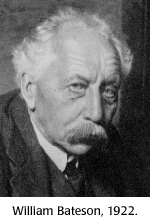Concept 5 Genetic inheritance follows rules.

 Reginald Punnett and William Bateson were among the first English geneticists. Punnett devised the "Punnett Square" to depict the number and variety of genetic combinations, and had a role in shaping the Hardy-Weinberg law. Punnett and Bateson co-discovered "coupling" or gene linkage. William Bateson brought Mendel's laws to the attention of English scientists.
Reginald Punnett and William Bateson were among the first English geneticists. Punnett devised the "Punnett Square" to depict the number and variety of genetic combinations, and had a role in shaping the Hardy-Weinberg law. Punnett and Bateson co-discovered "coupling" or gene linkage. William Bateson brought Mendel's laws to the attention of English scientists.
William Bateson (1861-1926)

William Bateson was born in Whitby, England. As a young boy, Bateson was asked what he wanted to be. He replied that he wanted to be a naturalist, but if he wasn't good enough then he would have to be a doctor. Bateson was not a star student - he didn't see the value of learning the "classics," and favored the natural sciences. In 1878, Bateson entered St. John's College at Cambridge University. His father was the master of the college at the time. As a student and later a researcher in Cambridge, Bateson was interested in species variation and heredity. He traveled to the Central Asian steppe and collected data on how environmental conditions relate to variation. In 1894, he published a book Materials for the Study of Variation based on his observations. In this book, he outlined the experimental approach that should be used to study inheritance. He was designing Mendelian experiments.
Around 1897, Bateson began doing some of these hybrid experiments with poultry and butterflies. When he read De Vries' and Mendel's papers, Bateson recognized the importance of "Mendelian Law," especially given his own experiments. By 1902, Bateson had translated Mendel's works into English and was a strong supporter of the Mendelian laws of inheritance. Bateson is credited with coining the terms "genetics," "allelomorphs" (later shortened to allele), "zygote," "heterozygote" and "homozygote." In 1908, as a Professor of Biology at Cambridge, Bateson helped establish the Cambridge School of Genetics.
Bateson left Cambridge in 1910 to accept the Directorship of the John Innes Horticultural Institute at Merton. He continued to have ties to Cambridge, collaborating with R. C. Punnett on genetic experiments and publications. Bateson and Punnett co-founded the Journal of Genetics in 1910.
Bateson's work and Bateson himself influenced other biologists and scientists such as Archibald Garrod, Thomas Hunt Morgan, and Charles Davenport. Bateson had a combative, forceful personality, well suited to his self-appointed role of Mendel advocate. However, Bateson was reluctant to believe in the chromosomal theory of inheritance. He was vocally antagonistic to the idea and it wasn't until 1922 after a visit to Thomas Hunt Morgan's fly lab that he publicly accepted chromosomes and their role in heredity.


Bateson's family life was quite tragic. One of his sons died just before the end of WWI, another committed suicide in 1922.

How important is it for scientists to work together and be aware of each other's results?
 Children resemble their parents.
Children resemble their parents. Genes come in pairs.
Genes come in pairs. Genes don't blend.
Genes don't blend. Some genes are dominant.
Some genes are dominant. Genetic inheritance follows rules.
Genetic inheritance follows rules. Genes are real things.
Genes are real things. All cells arise from pre-existing cells.
All cells arise from pre-existing cells. Sex cells have one set of chromosomes; body cells have two.
Sex cells have one set of chromosomes; body cells have two. Specialized chromosomes determine sex.
Specialized chromosomes determine sex. Chromosomes carry genes.
Chromosomes carry genes. Genes get shuffled when chromosomes exchange pieces.
Genes get shuffled when chromosomes exchange pieces. Evolution begins with the inheritance of gene variations.
Evolution begins with the inheritance of gene variations. Mendelian laws apply to human beings.
Mendelian laws apply to human beings. Mendelian genetics cannot fully explain human health and behavior.
Mendelian genetics cannot fully explain human health and behavior.